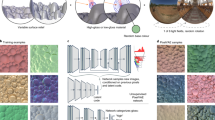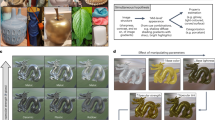Abstract
IMAGES of artificial and natural scenes typically contain many highlights generated by mirror-like reflection from glossy surfaces. Until recently, computational models of visual processes have tended to regard highlights as obscuring the structure of the underlying scene. The truth is that, on the contrary, highlights are rich in local geometric information. Here we report that the three-dimensional appearance of a highlight on a computer-simu-lated stereoscopic curved surface affects observers' judgment of surface gloss. We also show that the 3-D appearance of a highlight affects the perception of surface curvature—that is, it can force an ambiguous convex–concave figure to change state. We thus conclude that human visual analysis seems to employ a physical model of the interaction of light with curved surfaces, a model firmly based on ray optics and differential geometry.
This is a preview of subscription content, access via your institution
Access options
Subscribe to this journal
Receive 51 print issues and online access
$199.00 per year
only $3.90 per issue
Buy this article
- Purchase on Springer Link
- Instant access to full article PDF
Prices may be subject to local taxes which are calculated during checkout
Similar content being viewed by others
References
Blake, A. Proc. 9th Int. Joint Conf. on Artif. Intell. 973–976 (1985).
Blake, A. & Brelstaff, G. J., Proc. 2nd Int. Conf. comp. Vis. 394–403 (Institute of Electrical and Electronics Engineers, Washington DC, 1988).
Bülthoff, H. H. & Mallot, H. A. J. opt. Soc. Am. 5, 1749–1758 (1988).
Phong, B. T. Communs. Ass. comput. Mach. 18, 311–317 (1975).
Beck, J. Surface Color Perception (Cornell University Press, New York, 1972).
Greenberg, D. P. Science 244, 166–173 (1989).
Mayhew, J. E. W. & Longuet-Higgins, H. C. Nature 297, 376–379 (1982).
Blake, A. & Bülthoff, H. H. Artificial Intelligence Lab Memo 1149 (Massachusetts Institute of Technology, Cambridge, Massachusetts, 1989).
Ramachandran, V. Nature 331, 163–166 (1988).
Koenderink, J. J. & van Doorn, A. J. Optica Acta 27, 7, 981–996 (1976).
Mayhew, J. E. W. & Frisby, J. P. Artif. Intel. J. 17, 349–385 (1981).
Koenderink, J. J. & van Doorn, A. J. Biol. Cybern. 21, 29–35 (1976).
Zisserman, A., Giblin, P. & Blake, A. Image Vis. Comput. 7, 38–42 (1989).
Author information
Authors and Affiliations
Rights and permissions
About this article
Cite this article
Blake, A., Bülthoff, H. Does the brain know the physics of specular reflection?. Nature 343, 165–168 (1990). https://doi.org/10.1038/343165a0
Received:
Accepted:
Issue Date:
DOI: https://doi.org/10.1038/343165a0
This article is cited by
-
Material category of visual objects computed from specular image structure
Nature Human Behaviour (2023)
-
Structure and function of neural circuit related to gloss perception in the macaque inferior temporal cortex: a case report
Brain Structure and Function (2021)
-
The Highlight Ovals
Journal of Mathematical Imaging and Vision (2019)
-
Do specular highlights and the daylight locus act as cues for estimating illumination color from a single object?
Optical Review (2017)
-
Touch influences perceived gloss
Scientific Reports (2016)
Comments
By submitting a comment you agree to abide by our Terms and Community Guidelines. If you find something abusive or that does not comply with our terms or guidelines please flag it as inappropriate.



